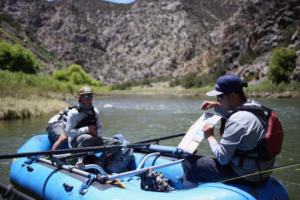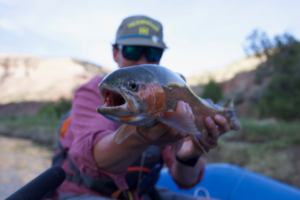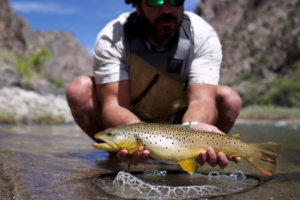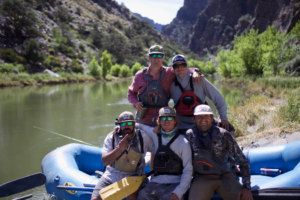Floating the Gunnison Gorge
It all started when my buddy Andrew and I were driving to the Arkansas River for a company work retreat. We were talking about all the rivers in Colorado that we have fished, and the ones that we haven’t. Most of the rivers in Colorado were blown out from the rapid snow melt, and thus unfishable. We both had the itch to go explore a new river, and we were scratching our heads about where to go. Andrew mentioned that he had some great luck on the Uncompahgre River last spring, and that it was only about a 30-minute drive from the Gunnison River. I wanted to make a full-day of it, so I suggested that we take a raft. I texted my ride-or-die fishing buddy JC, “Let’s go fish the Paco, and then pay for a jet boat shuttle to take us and the rafts up the Gunnison for the evening hatch.” “I’m in!” he said.
A few hours later, a group text had formed with five of the grittiest anglers I know – JC, Dave, John, Andrew, and myself. Dave said “I got a guy that can that can pack us in to the Gunnison Gorge on mules”. The Gunnison Gorge is a 14-mile stretch of river that is protected by wilderness. Meaning no motorized vehicles are allowed. It is some of the steepest, most rugged terrain in the state of Colorado, and contains about fifteen class III and IV rapids. This river is not for the faint-hearted. It will chew you up, and spit you out. Dave texted, “I called the outfitter to pack us in, but haven’t heard back.” From the trailhead to the river is around 1.1 miles, and 560-feet of elevation loss. It goes straight down into the Black Canyon. We were a little late to the party, and we all knew that if we didn’t hear back from the outfitter, we would have to carry the two rafts in on our backs. “We didn’t get sober to be little whiners, let’s do this!”, JC texted. If you’ve ever been in a group text with four sober dudes, you know how things can escalate…quickly. The plan went from a mellow jet-boat shuttle up river, to a full-bore 14-mile stretch of some of the most technical water in the state…in a matter of minutes.
Thursday night came, and still no word from the outfitter. We made plans to leave Carbondale on Friday evening when everyone was finished with work. We were going to camp at the trailhead, and wake up early Saturday morning to pack the rafts down into the river. We wanted to go ultra-light, and finish the 14-mile stretch in one day. Dave, JC, and I met at JC’s house to strip the rafts down to the bare-bone-essentials. We removed the front and rear lean bars, and the floors. All we had left on the frame was a seat for the oarsman, and the oar locks. We had to go as light as possible in order to pack the rafts down the steep trail. We deflated the rafts, and rolled them as tightly as possible. The rubber part of each raft weighs about 100 pounds. We loaded them into the back of Dave’s truck. We strapped the bare-bones raft frames to Dave’s trailer, along with 6 oars (two main oars, and 1 spare oar for each boat). The raft preparation was completed, and the excitement was starting to build.
Dave had floated this stretch of river a few years before, so we were banking on his knowledge of the class III and IV rapids. I had floated the lower 3 miles of this river on the exact same weekend a year prior. It was absolutely phenomenal fishing. I remember counting 5 different insect hatches: salmon flies, golden stones, yellow sallies, caddis and PMDs all hatched in the same evening last year. We had some intel from the local fly shops that the Salmon flies were beginning to hatch at Smith Fork, which is roughly halfway up the river. This was music to our ears. For all of you non-anglers, the salmon fly hatch is a dry fly fisherman’s dream. To throw a giant, two-inch, foam fly to a rising trout is the ultimate experience. Anglers travel from all over the world to try their hand at catching the salmon fly hatch just right. The problem is, salmon flies only hatch for about two weeks, and trout typically only feed on adult salmon flies (top water or dry flies) for a few days. They simply get too full from eating the 2 inch flies. Trout lose interest and won’t rise to the surface for them anymore. We knew we had a really good chance of hitting the hatch absolutely perfectly. But as they say, “you don’t know unless you go!”
Dave had Friday off from work, so we tasked him with getting all of the groceries and camping supplies. I’m not sure about the rest of the guys, but I certainly did not sleep well on Thursday night. I was so jazzed up about the possibility of presenting a two-inch dry fly to a rising trout. Not just any trout, either. The Gunnison River is known for producing 20+ inch carnivorous brown trout. 5:00pm finally came around, and I was out the front door of the office like I stole something. All five of us met at the City Market parking lot at 6:30pm to head out. We needed two vehicles, so we could run the shuttle after the float leaving a vehicle at the takeout. Dave’s truck was loaded to the gills with rafts and camping accessories. He was towing the trailer with the raft frames and oars, and I was following him in my vehicle. The stoke was high as we rendezvoused in the parking lot. Everyone was ready to be at the trailhead. We had about a three-hour drive ahead of us. Dave looked over at us and said, “baton down the hatches, boys…we’re in for a real adventure!”
We got to the dirt road that would take us to our campsite at around 10:00pm. I realized that in all the excitement of the trip, we forgot to drop my vehicle at the river take-out ramp. It is absolutely critical to leave a vehicle at the take-out ramp, otherwise you have no way to get back to the trailhead. With our foreheads in our palms, we tried to brainstorm some alternative solutions. Because the Gunnison Gorge is wilderness, it was going to take us about 3 hours to run the shuttle. You have to drive in a huge loop to get to Pleasure Park, where we would be taking the rafts off the river. We called the only fly shop in the area to see if we could arrange for a shuttle service. “I don’t have enough hands on deck to run your shuttle tomorrow, sorry.”, he said. “What if we pay you double? Will you do it then?” I asked. “No, we don’t have enough people.” Well, shit! We had two choices: run the shuttle tonight, or wake up super early and run the shuttle in the morning. We decided to run the shuttle that night.
We got to the campsite at around 11:00pm, and unloaded both vehicles. Dave, Andrew, and John decided they would stay at the campsite to get set up, and cook dinner. JC and I would run the shuttle. JC and I finished the shuttle, and returned to the campsite around 1:00am. John had just pulled the steaks off the fire. We shoveled the steak, corn and beans down our throats, and gathered around the fire to pack a post-meal chew. We were all exhausted, but there was definitely a buzz at camp. We all agreed to a 6:00am wake up call. It was going to be a long day, and we needed to get an early start to ensure we could cover 14-miles of river during day light hours.
The 6:00am alarm came just a few hours after we shut our eyes. Everyone was a little slow climbing out of their tents, but we woke to an incredible orange, purple and blue sunrise. It was a beautiful morning. After the sun rose, the clouds burned off and we had bluebird skies. Dave whipped up some killer breakfast burritos, and we gathered our gear. JC and I fashioned some backpack-style straps out of some old climbing rope that Dave had in the bed of his truck. We had to hoist the two raft rubbers onto JC’s and Dave’s backs to pack down the trail. The raft rubber is by far, the heaviest load. Each rubber weighs around 100-pounds, and we were using ropes as backpack straps. JC and Dave certainly had their work cut out for them, but they have an enormous amount of gravel in their guts. I knew they would be fine. We strapped all 6 oars together, and then the 2 external raft frames together. Andrew took the stack of oars, and John and I took the frames. The mercury was rising on the thermometer, and we hit the trailhead.
It took us about an hour to pack the rafts, frames and oars down to the river. It’s a steep ascent with a ton of switchbacks, and the footing is sketchy. Andrew took a tumble early while he was carrying the oars, but besides a little ego bruise, he was fine. We got to the boat launch, and were shocked to see about 15 other rafts ready to push off. Of course, we talked smack about them amongst each other. They were all fat Florida guys that were being guided, and we just sweated through our shirts packing our rafts down the steep canyon. We looked up the 600-foot canyon walls, and could immediately see salmon flies hatching. Like big-ass B.1 bombers flying around…we were stoked! We started inflating the rafts, adjusting the oar towers, and attaching the frames to the rubbers. The salmon flies were becoming more prevalent all the while. We knew we had hit the hatch absolutely perfectly, but there was still no guarantee that the fish would be eating them on top. We refilled our water jugs, and dropped iodine tablets in to purify the water. It was go time!
Dave, JC and John on one raft, and Andrew and I on the other. We agreed to let Dave’s boat take the lead, as I hadn’t rowed the Gunny before. It didn’t take long before we heard JC’s shouting bouncing off the canyon walls, “I GOT COLOR!” If you’ve ever watched Wicked Tuna on Discovery Channel, you know what the saying “I got color” means. For those of you that haven’t watched it, the guys scream “I got color” when they can finally see the tuna on the line. I saw Dave’s rod fully flexed, and I knew he had a big fish on the line. We hit the first pocket of soft water we could find, and eddied up. JC and Dave were screaming with excitement. Andrew quickly hopped out of my raft to capture the moment with his camera.
After some hesitation, Dave finally gave Andrew and I the intel on what kind of fly his fish took. It was a size 6 orange salmon fly stimulator, and that proved to be the breakfast, lunch, and dinner ticket for those big-ass Gunny browns all day! We figured it out within the first 15 minutes, and the trout were in for a long day.
The fishing remained lights-out for the rest of the morning, and we exchanged hoots and hollers off the canyon walls. It was hot, temperatures hit the mid-90s by noon, but the fishing was on fire! It was one of those days where your forearm starts to burn from fighting big trout. We eddied up for lunch, and went for a swim. I don’t think I’ve ever tasted a better PB&J sandwich, and neither had Dave.
We switched the personnel on the boats to keep it fresh. JC hopped in with Andrew and me, and we pushed on. The fishing remained incredible all day. There were periods when they wouldn’t eat salmon flies on top water, but they were crushing the golden stone nymphs we had dropped off the back of our salmon flies. We were dialed in, and the numbers were high. We were getting close to the infamous mile nine. Mile nine is a stretch of the Gunny with 5-6 consecutive technical class III and IV rapids. The flows were pretty friendly, but there was still plenty of sleeper rocks that we needed to avoid. We were ready for it.
The approach into mile 9 is a long stretch of calm water. We were bouncing our salmon flies off the canyon walls, and having a blast. We looked up river towards the first rapid, and saw something that caught our eyes. It appeared to be a blue raft wrapped around a rock. We were 600-700 yards away, but we thought we could see two guys standing on top of the rock, too. As we got closer to the rapid, we could tell they were in distress. We eddied up on the side of the river, and got out to assess the situation. We grabbed our throw ropes, and walked down the bank of the river to see what was going on. As we got closer, it was evident that these two guys had taken a really bad line through an unforgiving rapid. They pinned their raft right on a giant boulder in the middle of the river. The force of the river had ripped the frame from the raft rubber. The 2 guys were able to safely get off the boat and stand on the boulder, out of the water. The boulder was smack-dab in the middle of the river in an extremely dangerous rapid, and it was difficult to communicate with the stranded fisherman on the rock from the noise of the rushing water. It was immediately apparent that they were extremely rattled, and their raft wasn’t coming off the rock. After all, there was 1,200 CFS of water mashing it against a giant boulder.
We began to formulate a plan. We knew that we had to get the guys off the rock, but how? There was no way that they could safely jump from the rock and swim through the rapid. It was too dangerous. Luckily, they were floating with another boat, which was just downstream in a calm eddy catching their gear as it was wiped from the raft. If we could get them off the rock, they could join their friends downstream. There were 2 routes through the rapid, so we began debating which line to take, and who was going to row. The plan was for the guys to jump from the rock, on to the raft as it floated by. We knew it was dangerous, but it was the safest way to get them off the rock. We took our time making a decision. We were calm, cool, and collected. Not the case for the guys on the rock. Dave agreed to take the stick, and run the rapid and collect the stranded fisherman from the rock. As we walked back upstream to get in our rafts, another group of rafters floated up to us. We explained the situation to them, and they immediately sprang into action. Two guys from their group were trained in swift water rescue, and had all the equipment that we needed to pry the raft from the rock. A few minutes later, another group of fisherman arrived on the scene. By this time, we had 14 guys, and a z-pulley arranged. After about an hour of adjusting and pulling, we freed the raft from the rock. The guys were still stranded on the boulder, however. We let the swift water rescue trained rafters run the rapid, and scoop the stranded rafters from the rock. It wasn’t the most graceful rescue, but they pulled it off…safely! We gathered our gear, and pushed on.
It’s funny, we never once thought about leaving those guys stranded on the rock. It wasn’t an option. We put our own lives at stake to help 2 strangers out, because that’s what you do. Just like in sobriety. You help the suffering addict out. You share with others what was freely given to you. It’s our primary purpose. The rescue mission was definitely an eye-opener. It was a humbling experience, and it changed the entire vibe of the trip. Our senses were sharpened, and we meticulously picked our way through the rest of the rapids.
As we paddled through the evening, the fishing picked up. We hit the evening hatch perfectly, and netted a shitload more fish. We got to the takeout around 8:30pm sunburnt and hungry, but extremely satisfied. We loaded up the rafts, grabbed some Taco Bell, and hit the road. Floating the Gunnison Gorge is a memory that I will never forget. It was an adventure filled with highs, lows, laughs, lots of fish, and four of my dearest friends that share the common bond of sobriety.
Sloane B.



As Chief Executive Officer Bill provides leadership and manage all day-to-day operations of Jaywalker Lodge, an extended care residential addiction treatment program for adult men.











